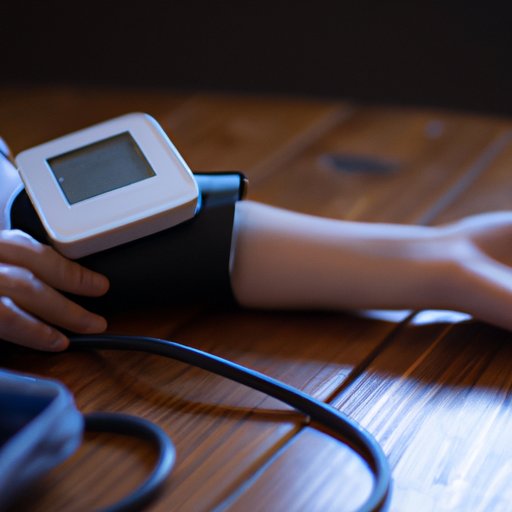
I. Introduction
High blood pressure affects millions of people worldwide and can lead to serious health complications. Regular monitoring of blood pressure is crucial in managing this condition, and doing it at home can be a convenient and cost-effective option. This article provides a step-by-step guide on how to take blood pressure at home, offering tips and insights along the way.
II. Step-by-Step Guide
Before starting, ensure that you are using a reliable and accurate blood pressure monitor. There are two types of monitors: manual and digital. Digital monitors are more common and user-friendly. Some come with helpful features, such as the ability to detect an irregular heartbeat. Choose one that has cuff sizes that fit your arm.
Next, sit in a quiet place that is free from distractions. Avoid intake of caffeine or exercise right before measuring blood pressure. Position your arm at heart level and rest it on a flat surface. Place the cuff around your upper arm, making sure it is snug but not too tight. Turn on the monitor and be ready to take your reading.
Start by taking three readings, with at least one minute of rest in between. The first reading may be higher than the subsequent ones; this is common due to the stress of the process. Record your readings in a diary or on your phone, making sure to include the date and time. Keep your records up to date, as your healthcare provider may need them to adjust your medications.
It is important to read the manufacturer’s instructions carefully and maintain your device regularly. Some monitors may need calibration or battery changes from time to time.
III. Do’s and Don’ts
Common mistakes made when taking blood pressure measurement include not resting long enough before measuring, or taking readings too close together. It is important to wait for at least a minute before taking a second measurement. Similarly, measurements should not be taken immediately after physical activity or a meal. It is also essential to ensure that the cuff is positioned correctly, not too tight or loose.
Best practices include taking readings at the same time and in the same position every day, emptying your bladder beforehand, and avoiding conversation during the measurement. Avoid crossing your legs or wearing tight clothing, as this can impact readings. If the readings seem unusual, contact your healthcare provider for guidance.
IV. Video Demonstration
Visual aids are always helpful, and video demonstrations provide a tangible view of the process. There are many videos available on YouTube, and many manufacturers also include instructions in the box with their devices. A video can provide a good example of what an optimal blood pressure reading looks like and can offer guidance on troubleshooting inaccurate readings.
V. Importance of Taking Blood Pressure at Home
Self-monitoring allows individuals to take charge of their health and track their progress. It can also help healthcare providers adjust medications more effectively and reduce the number of doctor’s appointments needed, resulting in a significant cost-saving. Self-monitoring can help people identify changes in their blood pressure and, therefore, can help them make informed decisions regarding their lifestyle.
Self-monitoring can also help in early detection of hypertension, which is usually asymptomatic in its early stages. Early detection can help in reducing its progression and preventing complications.
VI. Compare and Contrast
Home blood pressure monitors are convenient and cost-effective. The process is quick, and readings can be taken any time, without having to visit a healthcare facility. It also allows individuals to take measurements in a comfortable and familiar setting, which can lead to more accurate readings. Modern digital monitors are consistent, reliable, and user-friendly, and competing manufacturers have implemented a standardized validation process.
On the other hand, professional blood pressure measurements are taken by an experienced healthcare provider. Sometimes it can be more accurate and, critically, the healthcare provider can contextualize the reading by examining the patient or going through their medical history. Professional measurements can also lead to further testing- such as an EKG-for additional diagnostic procedures.
VII. Conclusion
Taking blood pressure at home is an easy and accurate process that can be done by anyone. Investing in the right equipment and following the right process ensures that the result obtained is reliable. It is crucial to keep a record of these readings, as they can help in disease detection and management. Remember to reach out to your healthcare provider if the readings are unusual or if there is a trend from what your healthcare provider has prescribed.




